Papers by Navid Mohammadi

PubMed, 2022
Introduction: Administration of intravenous vitamin C in hemodialysis patients can reduce their f... more Introduction: Administration of intravenous vitamin C in hemodialysis patients can reduce their ferritin levels. Nevertheless, little research has been carried out in this regard. Hence, this study aimed to determine the effect of intravenous vitamin C on ferritin levels in a group of hemodialysis patients. Methods: The study population included 32 patients with chronic renal failure undergoing hemodialysis who had been referred to Qazvin Hospital. These patients had functional iron deficiency (IDA) and high levels of serum ferritin. Patients were randomly allocated into intervention group A (n = 16) and control group B (n = 16). Group A was given intravenous ascorbic acid, while group B was given the same amount of distilled water as a placebo three times a week after each dialysis session for three months along with erythropoietin. Laboratory parameters were assessed at the beginning and the end in an interval of three months. Results: In patients who received vitamin C injections, the mean ferritin level decreased at the end of the study (P < .05). But vitamin C intake did not affect BUN, creatinine, sodium, potassium, TIBC, hemoglobin, platelets count, and the length and number of dialysis sessions. Conclusion: Results of our study showed that vitamin C can reduce serum ferritin levels in hemodialysis patients. Therefore, it can be used as an adjunct in the treatment of anemia in patients. DOI: 10.52547/ijkd.6531.
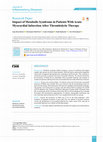
Background: Metabolic syndrome (MetS) comprises a group of conditions that happen together and in... more Background: Metabolic syndrome (MetS) comprises a group of conditions that happen together and increase the risk of heart disorders. MetS has known characteristic diagnostic criteria and is diagnosed through physical examination and blood tests. This syndrome is extremely prevalent in patients with acute myocardial infarction. We aimed to determine the prevalence of MetS and its relationship with myocardial infarction and response to treatment in patients suffering from acute myocardial infarction under fibrinolytic treatment. Methods: In this cross-sectional study, 145 patients with acute ST-elevation myocardial infarction (STEMI) were enrolled. They were referred to Bu-Ali Sina Hospital in Qazvin, Iran, between January 2018 and January 2019 and were candidates for thrombolytic therapy. The patients were divided into two groups with and without MetS according to the NCEP ATP III definition (the National Cholesterol Education Program-Adult Treatment Panel III). In each group, the ST resolution of more than 50% in electrocardiogram was evaluated 90 minutes after thrombolytic administration. In addition, angiographic information and left ventricular ejection fraction (LVEF) were compared between the two groups. Results: Overall, the prevalence of MetS was 57.2% in the study population. After treatment, ST-segment resolution of more than 50%, the number of involved coronary vessels, the thrombolysis in myocardial infarction flow grade, mean LVEF, and type of myocardial infarction were similar in both study groups. Conclusion: Our study indicates that MetS does not affect the response rate to thrombolytic treatment.
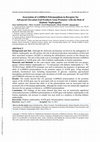
Scientific journal of Kurdistan University of Medical Sciences, Aug 1, 2022
Background and Aim: Although the molecular mechanisms involved in the pathogenesis of diabetic ne... more Background and Aim: Although the molecular mechanisms involved in the pathogenesis of diabetic nephropathy are still unclear, the role of advanced glycation end products (AGEs) and their associated receptors (AGER) in initiating the inflammatory process in this disease has attracted attention. The aim of this study was to investigate the relationship between rs1800624 polymorphism of AGER gene with risk of diabetic nephropathy in Iranian population. Materials and Methods: In this case-control study, patients were divided into two groups, group1 without diabetic nephropathy (n = 71) and group2 with diabetic nephropathy (n = 79). TETRA-Primer ARMS-PCR technique was used to determine the frequency of genotype and allele of rs1800624 polymorphism in the promoter region of AGER gene. Using standard methods, biochemical tests including measurement of glucose, creatinine, glycosylated hemoglobin and blood urea nitrogen and calculation of eGFR were performed. We used SPSS and FAMHAP softwares for data analysis. Results: The results showed that AA genotype rs1800624 polymorphism in the promoter region of the AGER gene may be associated with an increased risk of diabetic nephropathy. Allele analysis also showed that allele A of the polymorphism may be associated with an increased risk of developing nephropathy, although the results were not statistically significant between the two groups in relation to rs1800624 polymorphism. Conclusion: The findings of this study showed that there was no statistically significant relationship between rs1800624 polymorphism in AGER gene with diabetic nephropathy in the Iranian population, but increase in sample size may result in a tendency to develop diabetic nephropathy.
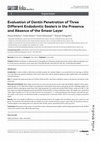
Folia Medica, Dec 31, 2022
Introduction: A sealer's ability to effectively and stably penetrate the dentinal tubules is an e... more Introduction: A sealer's ability to effectively and stably penetrate the dentinal tubules is an essential factor for selecting an effective root canal obturation material. Evaluation of the sealers' penetration into the dentinal tubules provides valuable data in the endodontic treatment outcome. Aim: To compare the dentin penetration of AH Plus, Endoseal MTA, and Syntex endodontic sealers in the presence and absence of the smear layer. Materials and methods: Thirty single-rooted teeth were selected in the present in vitro study and randomly assigned to three experimental groups (n=10). Half of the samples were prepared by removing the smear layer in each group, and the remaining samples were prepared without removing the smear layer. Root canal preparation was carried out with the Perfect Rotary system up to file T3. The root canals were obturated with gutta-percha and AH Plus, Endoseal MTA, or Syntex endodontic sealers. The samples were incubated at 100% relative humidity at 37°C for one week. Each root was sectioned at 2-, 5-, and 8-mm distances from the apex, and sealer penetration depth at each section was determined under a scanning electron microscope (SEM). ANOVA was used to compare penetration depths. Results: There were significant differences in sealer penetration between the samples with and without smear layer removal in each group. The maximum and minimum sealer penetration was at the coronal and apical sections, respectively. The maximum sealer penetration depths in descending order were observed with AH Plus, Syntex, and Endoseal MTA sealers (p<0.05). Conclusions: Elimination of smear layer increased three sealers' dentin penetration depth, with the deepest penetration for the AH Plus sealer in the coronal section without the smear layer.
Razi Journal of Medical Sciences, Sep 10, 2018

DOAJ (DOAJ: Directory of Open Access Journals), Apr 1, 2014
ABSTRACT Abstract Background: Most of the studies support the statement that maternal periodontit... more ABSTRACT Abstract Background: Most of the studies support the statement that maternal periodontitis may be a risk factor for infants with preterm delivery and low-birth-weight (PLBW). The aim of the present research was to determine the effects of periodontal treatment on incidence of PLBW among women with mild to moderate periodontitis. Methods: 60 pregnant women received dental and periodontal examination [probing depth (PD), clinical attachment level (CAL), and bleeding on probing (BOP)]. 30 of these pregnant women (the treatment group) received professional oral hygiene treatment including plaque and calculus removal and root planning at the beginning and end of 8th month of pregnancy. The control group just received the periodontal examination. The mean length of pregnancy and birth-weight were compared between the groups. Statistical analysis was determined using Kolmogorov-Smirnov, independent-sample t, Mann- Whitney U, Pearson and Spearman tests. Findings: The incidence of PLBW in treatment group was significantly lower than the control group (P = 0.006). No correlation was found between clinical parameters and the time of pregnancy or infant&amp;#39;s weight. There was a weak positive correlation between the infant&amp;#39;s weight and the improvement of clinical parameters. Conclusion: The results support the hypothesis that maternal periodontal disease is associated with infant prematurity and low birth weight. Therefore, the periodontal treatment can contribute to optimal date of delivery and achieving greater birth-weight. Keywords: Periodontal disease, Low birth weight, Pregnancy, Preterm delivery and low-birth-weight (PLBW)

PubMed, 2022
Background: A new method to improve the properties of the materials is nano-encapsulation, which ... more Background: A new method to improve the properties of the materials is nano-encapsulation, which improves the biological properties, antibacterial activity along with reduction of toxicity. Due to the spread of nano-knowledge, the present study was performed to evaluate the antibacterial effect of nano-chlorhexidine (CHX) on Enterococcus faecalis biofilm in the root canal system. Materials and methods: In this in vitro experimental study, 55 matured single-root mandibular premolars were decoronated and the canals were prepared by single length method up to #F3 ProTaper Universal system. Five teeth were selected as negative control. Then, the teeth were randomly divided into three experimental groups (n = 15) and a positive control group (n = 5). The experimental groups were irrigated with 2% nano- CHX gel, 2% CHX solution, and 5.25% sodium hypochlorite (NaOCl), respectively. Finally, the number of colonies was counted. Kruskal-Wallis test was used to compare the number of colonies among groups. The level of significance was set at P < 0.05. Results: The mean number of colonies in the groups of nano-CHX, NaOCl, CHX, and positive control were obtained as 17.73 ± 18.69, 35.53 ± 36.42, 38.8 ± 31.8, and 96.8 ± 22.52, respectively. There was a significant decrease in the number of colonies in all the experimental groups compared to the control group (P < 0.05). However, difference in the number of colonies among these three groups was not significant (P > 0.05). Conclusion: The use of nano-CHX in removing E. faecalis biofilm from root canal is as effective as the use of CHX and NaOCl.
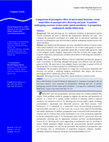
PubMed, 2018
Background: Pain and shivering are two unpleasant problems in postoperative period. Various techn... more Background: Pain and shivering are two unpleasant problems in postoperative period. Various techniques are used to alleviate the postoperative shivering and pain. We compared the preemptive prescription of a single dose of intravenous meperidine and ketorolac on postoperative pain and shivering in patients undergoing cesarean section with spinal anesthesia. Methods: One hundred and fifty patients who were scheduled for elective cesarean section under spinal anesthesia were randomly allocated to one of three study groups to receive intravenous ketorolac (group K), meperidine (group M) or normal saline (group P). Time to first analgesic request, analgesic requirement in the first 24 hours after surgery, body tympanic temperature, hemodynamic variables and incidence of shivering were assessed as outcome variables. Results: There was no significant difference between meperidine and ketorolac groups in terms of prevalence of shivering, although both groups were different from the placebo group (p<0.04). The mean time to first analgesic request was longer in group k (3.8±1.4) and groups M (3.3±1.2) than in group P (2.1±0.8) hours (p<0.001). Conclusions: The preemptive prescription of a single dose of intravenous meperidine and ketorolac can provide a satisfying analgesia immediately after surgery and decrease shivering prevalence without any serious side effects.
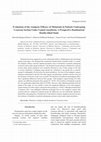
PubMed, 2016
Melatonin has been suggested as a new natural pain killer in inflammatory pain and during surgica... more Melatonin has been suggested as a new natural pain killer in inflammatory pain and during surgical procedures. We designed this randomized double-blind controlled study to evaluate the analgesic efficacy and also optimal preemptive dose of melatonin in patients undergoing cesarean section under spinal anesthesia . One hundred twenty patients scheduled for cesarean section under spinal anesthesia were randomly allocated to one of three groups of 40 each to receive melatonin 3 milligram (mg) (group M3), melatonin 6 mg (group M6) or placebo (group P) sublingually 20 min before the spinal anesthesia. The time to first analgesic request, analgesic requirement in the first 24 h after surgery, hemodynamic variables, anxiety scores nd the incidence of adverse events were recorded. The duration of anesthesia and analgesia didn't show significant differences between three groups. Total analgesic request during 24 h after surgery was different among the three groups (P = 0.035). The incidence of headache in group M6 was significantly higher than others (P<0.001). However, after adjusting headache between groups of the study, we were unable to show the significant difference in the total analgesic request during 24 h after surgery among the three groups (p = 0.058). Although premedication of patients with 3 mg sublingual melatonin prolonged time to first analgesic request after cesarean delivery compared to placebo group, the difference was not statistically significant. Meanwhile increasing dose of melatonin to 6 mg failed to enhance analgesia and also increase the incidence of headache in patients undergoing cesarean section under spinal anesthesia.
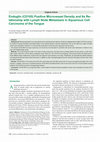
Archives of Iranian Medicine, Jul 1, 2011
Background: Neovascularization is an important factor for predicting tumor behavior. Evidence sug... more Background: Neovascularization is an important factor for predicting tumor behavior. Evidence suggests that endoglin (CD105) is a powerful marker of neovascularization and determination of microvessel density in several malignancies, and can be used as an agent to predict lymph node metastasis. However, it is controversial, particularly in head and neck squamous cell carcinoma. We studied CD105-MVD in tongue squamous cell carcinoma and evaluated its correlation with lymph node metastasis in relation to sex, age, and histopathologic grade. Methods: This study analyzed a total of 40 cases of tongue squamous cell carcinoma by dividing patients into two groups, a) with metastatic lymph nodes (N+) and b) without metastatic lymph nodes (N-). By CD105 immunostaining, microvessel density was determined in three different areas (intratumoral, invasive front and adjacent normal tissue) of all cases. Statistically, we evaluated the relation between microvessel density and lymph node involvement, in addition to other clinicopathologic factors by using the Kolmogorov-Smirnov test, t-test, and other analyses. Results: CD105-MVD in the invasive front (P≤0.001) and intratumoral (P≤0.006) areas of the N+ group was significantly higher than in the N-group. In addition, there was a correlation between CD105-MVD and differentiation in the invasive front area (P≤ 0.013) No relation existed between CD105-MVD and other clinicopathologic features. Conclusion: CD105-MVD, as a prognostic factor, may be helpful for determining the possibility of lymph node metastasis of primary SCC of the tongue.
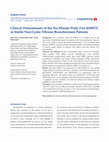
PubMed, Dec 1, 2020
Background: The six-minute walk test (6MWT) is a suitable tool for the assessment of functional c... more Background: The six-minute walk test (6MWT) is a suitable tool for the assessment of functional capacity in patients with chronic pulmonary diseases. This study aimed to assess the clinical determinants of the six-minute walk distance (6MWD), exercise-induced desaturation (EID), and pretest saturation of arterial oxygen (SataO2) in patients with diffuse non-cystic fibrosis (CF) bronchiectasis. Materials and methods: In this cross-sectional study, a total of 57 clinically stable patients with diffuse non-CF bronchiectasis were enrolled. Anthropometric measurements (body mass index [BMI], mid-arm muscle circumference [MAMC], and triceps skinfold thickness [TSF]), spirometric indices (forced expiratory volume in one second [FEV1], forced vital capacity [FVC], and FEV1/FVC ratio), imaging assessment (CT scan), and bacteriological sputum studies were performed, and then, 6MWT was carried out. Results: The mean 6MWD was measured to be 447.11±94.59 m. The average walked distance in patients with severe, moderate, and mild bronchiectasis was 427.73±92.07, 439.63±102.65, and 485.87±80.47 m, respectively, with no significant difference. The pretest SataO2 was 88.92±5.59%, 93.75±3.36%, and 94.87±2.88% in the severe, moderate, and mild bronchiectasis groups (P<0.001). A significant inverse correlation was observed between the distance walked and BMI (r=-0.434, P=0.001). Conclusion: The predictors of 6MWD in stable non-CF bronchiectasis patients were FVC, SataO2 at rest, BMI, and MAMC. The FEV1, FEV1/FVC, and BMI were independent predictors of SataO2 at rest. The extension of bronchiectasis was the only predictor of EID during the test.
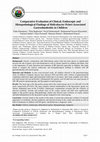
International Journal of Pediatrics, Mar 1, 2021
Background: Chronic colonization with Helicobacter pylori (Hp) has been shown to significantly in... more Background: Chronic colonization with Helicobacter pylori (Hp) has been shown to significantly increase the risk of gastric ulcer and duodenum as well as chronic gastritis in children and adults. Due to the importance of early detection and treatment of HP infection especially in children, this study aimed to compare the clinical, endoscopic and histopathological findings in children with HP gastroduodenitis and control group. Materials and Methods: In this cross-sectional study, all children referred to the gastroenterology clinic of children´s hospital, Qazvin, Iran, between 2016 and 2018, with a history of gastrointestinal complaints underwent upper gastrointestinal endoscopy if necessary, then tissue samples were taken, and rapid urease test was performed. Subsequently the patients were divided into two equal groups of 200: HP positive (patient group), and Hp negative (control group). Results: The mean age in the Hp positive group and in the control group was 8.11±3.68 and7.22±2.96 years, respectively (P<0.05). The most common clinical manifestation in the Hp positive group was chronic abdominal pain (n=66, P<0.001). Endoscopic examinations revealed that the evidence of mucosal erythema, erosions and nodular mass of the corpus, antrum and bulb were significantly higher in Hp positive group. Histopathologic studies also showed more evidence of corpus, antrum and bulb inflammation in the Hp positive group compared to the control group. Conclusion: Overall, based on the results of this study, it seems that endoscopic evidence of mucosal appearance of erythema, obvious nodularity and mucosal erosion in the corpus and antrum as well as bulb of duodenum in children with HP gastro-duodenitis has a diagnostic value.
Journal of renal injury prevention, Mar 28, 2020
In a double blind clinical trial on 32 hemodialysis patients who suffered from intradialytic hypo... more In a double blind clinical trial on 32 hemodialysis patients who suffered from intradialytic hypotension, in more than 50% of dialysis sessions, we found that the administration of sertraline or L-carnitine for one month could significantly increase the mean systolic blood pressure, mean diastolic blood pressure, and mean arterial pressure and also nadir blood pressures while there was no significant difference between both drugs.
Scientific Journal of Hamadan University of Medical Sciences, Sep 15, 2010
Results: After the study there was a significant improvement of FBS and TG in metformin group ver... more Results: After the study there was a significant improvement of FBS and TG in metformin group versus placebo group (P= 0.02 and P= 0.028 in order). But, there was not significant difference in other variables such as BMI, insulin dosage, HbA1C, Cholesterol and LDL between the two groups. Conclusion: Metformin treatment in teenagers with type1 DM who are in pubertal period will improve the control of FBS and lowers TG but has not any significant effect on HbA1C, BMI, insulin dosage, Cholesterol and LDL.
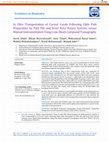
Frontiers in dentistry, Nov 24, 2020
This study aimed to assess root canal transportation of curved canals following glide path prepar... more This study aimed to assess root canal transportation of curved canals following glide path preparation by PathFile and Scout RaCe rotary systems compared with manual instrumentation with stainless steel (SS) hand files using cone-beam computed tomography (CBCT). Materials and Methods: This in-vitro experimental study was conducted on extracted human mandibular first and second molars (n=51) with 25-45° canal curvature in their mesiobuccal root. All teeth underwent CBCT and were randomly divided into three groups (n=17). In group 1, a glide path in the mesiobuccal canal was created using SS hand files to the working length. In groups 2 and 3, after canal negotiation with a #8 SS hand file, a glide path was created with PathFile and Scout RaCe systems, respectively. The teeth underwent CBCT. Pre-and postoperative CBCT scans were compared to calculate the magnitude of canal transportation at 3, 6, and 9 mm from the apex. The results were analyzed using the Kruskal-Wallis and Freedman tests (P<0.05). Results: Manual instrumentation caused significantly higher canal transportation at 3 and 9 mm from the apex compared with rotary systems (P<0.05). PathFile and Scout RaCe were not significantly different at 3 (P=0.39) or 9 mm (P=0.99). No significant difference was noted in canal transportation among the three groups at 6 mm (P=0.15). Conclusion: Scout RaCe and PathFile cause less canal transportation than manual instrumentation with SS files when used for glide path preparation in curved canals, especially in the apical third.
Acta Anaesthesiologica Taiwanica, Dec 1, 2013
This article appeared in a journal published by Elsevier. The attached copy is furnished to the a... more This article appeared in a journal published by Elsevier. The attached copy is furnished to the author for internal non-commercial research and education use, including for instruction at the authors institution and sharing with colleagues. Other uses, including reproduction and distribution, or selling or licensing copies, or posting to personal, institutional or third party websites are prohibited. In most cases authors are permitted to post their version of the article (e.g. in Word or Tex form) to their personal website or institutional repository. Authors requiring further information regarding Elsevier's archiving and manuscript policies are encouraged to visit: http://www.elsevier.com/authorsrights
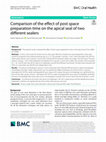
BMC Oral Health, Aug 17, 2022
Background: The present study compared the effect of post space preparation time on the apical se... more Background: The present study compared the effect of post space preparation time on the apical seal of two different sealers. Methods: In the in vitro study, 94 central incisors were used. After the samples' root canal preparation, they were randomly assigned to four experimental groups (n = 21). The samples in groups 1 and 2 were obturated with AH Plus sealer, gutta-percha, and in groups 3 and 4 with Endoseal MTA bioceramic sealer and single cone technique. The post spaces in groups 1 and 3 were prepared immediately and in groups 2 and 4 with a delay. The samples were evaluated at 7-, 30-, and 90-day intervals for apical microleakage using the fluid filtration technique. The data were analyzed with SPSS 25, using three-way ANOVA and independent t-test. Results: The apical microleakage in groups 3 and 4, obturated with Endoseal MTA bioceramic sealer and prepared immediately and after a delay, respectively, was not significantly different between the interval times. In group 2, obturated with AH Plus sealer and prepared for post space with a delay, the apical microleakage was significantly less than all the other groups. Group 1, obturated with AH Plus sealer and prepared for post space immediately, exhibited the least microleakage after seven days, but its microleakage increased over time to reach the level of groups 3 and 4. Conclusion: According to the results, the apical microleakage in the AH + sealer group and the delayed post-space preparation method, was significantly less than all the other groups over time.
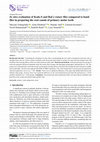
Frontiers in bioscience, Jun 2, 2022
Background and aims: Considering the advantages of rotary files in instrumenting the root canals ... more Background and aims: Considering the advantages of rotary files in instrumenting the root canals of permanent teeth and a lack of adequate data on the use of these systems in primary teeth, the present study aimed to evaluate two rotary files and compare them with hand files in the cleaning efficacy of the root canals of primary molar teeth. Materials and methods: In the present study, three groups of teeth were prepared with Kedo-S paediatric rotary file system, RaCe (reamer with alternating cutting edges), and hand files (n = 40). The groups were evaluated under a stereomicroscope concerning the cleaning efficacy of the files after cleaning the teeth in the apical, middle, and coronal thirds. The data were analyzed with SPSS 24 (IBM Corporation, USA, 2016) using Fisher's exact test and chi-squared test; statistical significance was set at p < 0.05. Results: There were no significant differences in the apical and middle thirds between the different study groups. However, there were significant differences in the coronal third between the hand file and Kedo-S (p = 0.016) and RaCe and Kedo-S (p = 0.001) groups. Conclusions: The present study showed that Kedo-S files were more effective than RaCe and hand files in the coronal area than the hand and RaCe files.
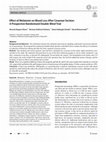
The Journal of Obstetrics and Gynecology of India, Apr 24, 2019
Background and Objectives The similarities between the melatonin and oxytocin signaling could lea... more Background and Objectives The similarities between the melatonin and oxytocin signaling could lead to increased contractility of myometrium. We designed this randomized double-blind, placebo-controlled trial to evaluate the efficacy of melatonin in reduction of blood loss during and after the lower segment cesarean section. Methods One hundred and twenty patients who had been scheduled for cesarean section under spinal anesthesia were enrolled in the study. We randomly allocated them to one of the three following groups to receive either melatonin 3 mg (M 3), melatonin 6 mg (M 6), or placebo (P) sublingually 20 min before the surgery. The hemoglobin levels before and 12 h after surgery, the mean weight of the materials used in the operation time, the need for additional oxytocic therapy, and the incidence of adverse effects were probed and recorded. Results There was a significant difference between the group M 6 and both M 3 and P in the mean weight of the materials (p = .024 and .041, respectively) and between M 6 and P groups in terms of mean decrease in hemoglobin during 12 h after cesarean section (p = .029). Conclusion Using 6 mg melatonin, sublingually, as a premedication in patients undergoing cesarean section with spinal anesthesia could statistically reduce the amount of blood loss after the lower segment cesarean section, although it may not be clinically meaningful. Registration number: ACTRN12612000117819 and ClinicalTrials.gov Identifier: NCT01572805 Keywords Melatonin • Blood loss • Cesarean • Spinal anesthesia Marzieh Beigom Khezri is working as associate professor of anesthesia in a tertiary teaching hospital, specialized for obstetrics and gynecology affiliated to Qazvin University of medical science. Her areas of interest in research are mostly in the fields of post-operative pain and obstetric hemorrhage management; Morteza Delkhosh Reihany has worked as an anesthesiologist since 2013. He completed his fellowship in palliative medicine last year. Furthermore, he works as an anesthesiologist and also in pain clinic for relieving chronic pains now. Dr. Delkhosh is interested in clinical research in the field of pain and advanced methods of anesthesia; Talaat Dabbaghi Ghaleh is an expert gynecologist with 24 years of educational and academic experience. She has also completed a fellowship in infertility and works in an infertility clinic too. Dr.
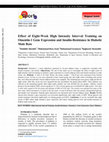
Annals of Applied Sport Science, 2017
Background. Omentin-1, a novel adipokine expressed in visceral adipose tissue, is negatively corr... more Background. Omentin-1, a novel adipokine expressed in visceral adipose tissue, is negatively correlated with insulin-resistance and obesity. Objective(s). The aim of this study was to investigate the effect of eight weeks of high-intensity interval training on omentin-1 gene expression in visceral adipose tissue and insulin-resistance in male wistar rats. Methods. A total of 26 male Wistar rats (mean weight = 110±10 gr) were purchased from Pasteur Institute in Iran. At first, six rats were separated as base control group and, after eight weeks of feeding with normal diet, were dissected and their visceral adipose tissues were sampled. The remaining rats were given a high-fat diet for eight weeks. After this, seven rats were separated into the non-diabetic fat group (obese HIIT). Then, diabetes was induced on the remaining animals After eight weeks, diabetic rats were divided into two groups-diabetic control group (n=6) and diabetic HIIT exercise group (n=7). The exercise group ran on treadmill for eight weeks-five days a week with a speed of 29-36 m/min and intensity of 90% of VO2 max. The activity was repeated five times in the first week, which increased to 12 times in the last week. A total of 48 hours after last session, fasting blood glucose and insulin were measured. Omentin gene expression was measured from visceral adipose tissue. Results. Results showed that omentin-1 gene expression was increased significantly after eight weeks of HIIT. Blood glucose and insulin-resistance decreased significantly in training groups (p=0.001). Conclusion. It can be concluded that eight weeks of HIIT induce high omentin-1 gene expression and reduce fasting glucose level and insulin-resistance in diabetic male wistar rats.










Uploads
Papers by Navid Mohammadi